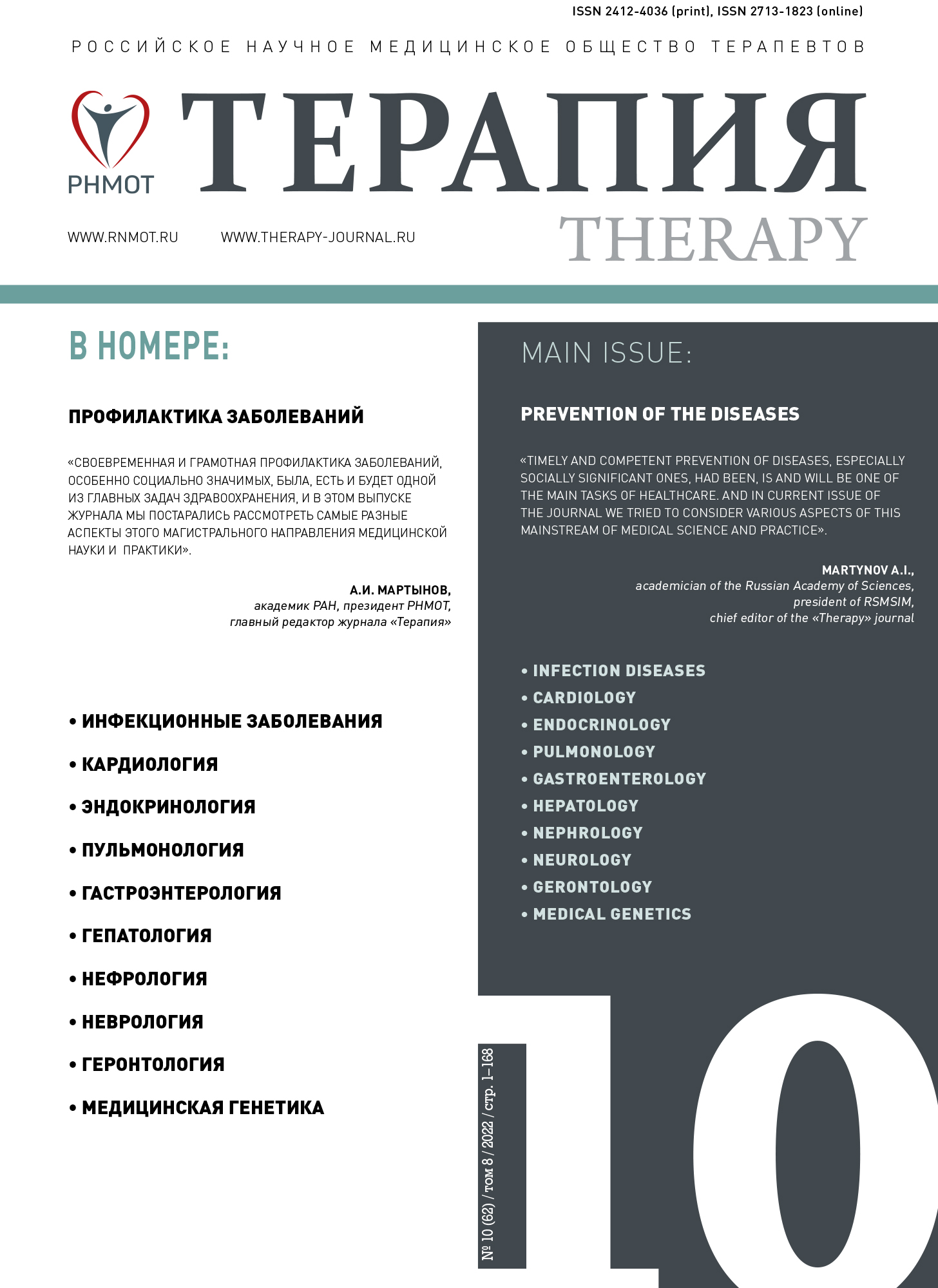Clinical and laboratory features of hospitalized patients with COVID-19 infection and coronary heart disease
- Authors: Markelova O.A.1, Vezikova N.N.1, Egorova I.S.1, Koryakova N.V.1
-
Affiliations:
- Petrozavodsk State University
- Issue: Vol 8, No 10 (2022)
- Pages: 21-30
- Section: Articles
- Published: 15.10.2022
- URL: https://journals.eco-vector.com/2412-4036/article/view/276795
- DOI: https://doi.org/10.18565/therapy.2022.10.21-30
- ID: 276795
Cite item
Abstract
Full Text
About the authors
Olga A. Markelova
Petrozavodsk State Universityemployee of the Department of hospital therapy of the postgraduate course in pulmonology, teacher of the course of therapy
Natalya N. Vezikova
Petrozavodsk State University
Email: vezikov23@mail.ru
Dr. med. habil., professor, head of the Department of hospital therapy
Inga S. Egorova
Petrozavodsk State University
Email: inga.skopets@gmail.com
PhD in Medicine, associate professor of the Department of hospital therapy
Nina V. Koryakova
Petrozavodsk State UniversityPhD in Medicine, associate professor of the Department of hospital therapy
References
- Пескова Ю. Церебральные и кардиоваскулярные осложнения COVID-19 в реальной клинической практике. Невроньюс (электронное издание). 2021; 10: 8-9. Доступ: http://neuronews.rU/preview/2021-10/#neuronews_1084_2021/page/8-9 (дата обращения - 01.11.2022).
- Barison A., Aimo A., Castiglione V. et al. Cardiovascular disease and COVID-19: Les liaisons dangereuses. Eur J. Prev Cardiol. 2020; 27(10): 1017-25. https://dx.doi.org/10.1177/2047487320924501.
- Madjid M., Safavi-Naeini P., Solomon S.D., Vardeny O. Potential effects of coronaviruses on the cardiovascular system: A review. JAMA Cardiol. 2020; 5(7): 831-40. https://dx.doi.org/10.1001/jamacardio.2020.1286.
- Hoffmann M., Kleine-Weber H., Schroeder S. et al. SARS-CoV-2 cell entry depends on ACE2 and TMPRSS2 and is blocked by a clinically proven protease inhibitor. Cell. 2020; 181(2): 271-80.e8. https://dx.doi.org/10.1016/j.cell.2020.02.052.
- Tucker N.R., Chaffin M., Bedi K.C. Jr et al.; Human Cell Atlas Lung Biological Network Consortium Members. Myocyte-specific upregulation of ACE2 in cardiovascular disease: Implications for SARS-CoV-2-mediated myocarditis. Circulation. 2020; 142(7): 708-10. https://dx.doi.org/10.1161/CIRCULATIONAHA.120.047911.
- Oudit G.Y., Kassiri Z., Jiang C. et al. SARS-coronavirus modulation of myocardial ACE2 expression and inflammation in patients with SARS. Eur J. Clin Invest. 2009; 39(7): 618-25. https://dx.doi.org/10.1111/j.1365-2362.2009.02153.x.
- Kaye M. SARS-associated coronavirus replication in cell lines. Emerg Infect Dis. 2006; 12(1): 128-33. https://dx.doi.org/10.3201/eid1201.050496.
- Bose R.J.C., McCarthy J.R. Direct SARS-CoV-2 infection of the heart potentiates the cardiovascular sequelae of COVID-19. Drug Discov Today. 2020; 25(9): 1559-60. https://dx.doi.org/10.1016/j.drudis.2020.06.021.
- Sharma A., Garcia Jr G., Arumugaswami V. et al. HumaniPSC-derived cardiomyocytes are susceptible to SARS-CoV-2 infection. bioRxiv. 2020. https://dx.doi.org/10.1101/2020.04.21.051912. Preprint.
- Shi S., Qin M., Shen B. et al. Association of cardiac injury with mortality in hospitalized patients with COVID-19 in Wuhan, China. JAMA Cardiol. 2020; 5(7): 802-10. https://dx.doi.org/10.1001/jamacardio.2020.0950.
- Wu Z., McGoogan J.M. Characteristics of and important lessons from the coronavirus disease 2019 (COVID-19) outbreak in China: Summary of a report of 72 314 cases from the Chinese Center for Disease Control and Prevention. JAMA. 2020; 323(13): 1239-42. https://dx.doi.org/10.1001/jama.2020.2648.
- Lake M.A. What we know so far: COVID-19 current clinical knowledge and research. Clin Med (Lond). 2020; 20(2): 124-27. https://dx.doi.org/10.7861/clinmed.2019-coron.
- He L., Mae M.A., Sun Y. et al. Pericyte-specific vascular expression of SARS-CoV-2 receptor ACE2 - implications for microvascular inflammation and hypercoagulopathy in COVID-19 patients 2020. bioRxiv. 2020.05.11.088500. https://dx.doi.org/10.1101/2020.05.11.088500. Preprint.
- Corrales-Medina V.F., Musher D.M., Shachkina S. et al. Acute pneumonia and the cardiovascular system. Lancet. 2013; 381(9865): 496-505. https://dx.doi.org/10.1016/S0140-6736(12)61266-5.
- Varga Z., Flammer A.J., Steiger P. et al. Endothelial cell infection and endotheliitis in COVID-19. Lancet. 2020; 395(10234): 1417-18. https://dx.doi.org/10.1016/S0140-6736(20)30937-5.
- Buja L.M., Wolf D.A., Zhao B. et al. The emerging spectrum of cardiopulmonary pathology of the coronavirus disease 2019 (COVID-19): Report of 3 autopsies from Houston, Texas, and review of autopsy findings from other United States cities. Cardiovasc Pathol. 2020; 48: 107233. https://dx.doi.org/10.1016/j.carpath.2020.107233.
- Saba L., Sverzellati N. Is COVID evolution due to occurrence of pulmonary vascular thrombosis? J. Thorac Imaging. 2020; 35(6): 344-45. https://dx.doi.org/10.1097/RTI.0000000000000530.
- Sardu C., Gambardella J., Morelli M.B. et al. Hypertension, thrombosis, kidney failure, and diabetes: Is COVID-19 an endothelial disease? A comprehensive evaluation of clinical and basic evidence. J. Clin Med. 2020; 9(5): 1417. https://dx.doi.org/10.3390/jcm9051417.
- Wu J., Mamas M., Rashid M. et al. Patient response, treatments, and mortality for acute myocardial infarction during the COVID-19 pandemic. Eur Heart J. Qual Care Clin Outcomes. 2021; 7(3): 238-46. https://dx.doi.org/10.1093/ehjqcco/qcaa062.
- Van den Berg V.J., Umans V.A.W.M., Brankovic M. et al.; BIOMArCS investigators. Stabilization patterns and variability of hs-CRP, NT-proBNP and ST2 during 1 year after acute coronary syndrome admission: Results of the BIOMArCS study. Clin Chem Lab Med. 2020; 58(12): 2099-106. https://dx.doi.org/10.1515/cclm-2019-1320.
- Chen C., Yan J.T., Zhou N. et al. [Analysis of myocardial injury in patients with COVID-19 and association between concomitant cardiovascular diseases and severity of COVID-19]. Zhonghua Xin Xue Guan Bing Za Zhi. 2020; 48(7): 567-71 (In Chinese)]. https ://dx.doi.org/10.3760/cma.j.cn112148-20200225-00123.
- Knuuti J., Wijns W., Saraste A. et al. 2019 Рекомендации ESC по диагностике и лечению хронического коронарного синдрома. Российский кардиологический журнал. 2020; 25(2): 119-182. [Knuuti J., Wijns W., Saraste A. et al. 2019 ESC Guidelines for the diagnosis and management of chronic coronary syndromes The Task Force for the diagnosis and management of chronic coronary syndromes of the European Society of Cardiology (ESC). Rossiyskiy kardiologicheskiy zhurnal = Russian Journal of Cardiology. 2020; 25(2): 119-182 (In Russ.)]. https://dx.doi.org/10.15829/1560-4071-2020-2-3757. EDN: TLYYDR.
Supplementary files








